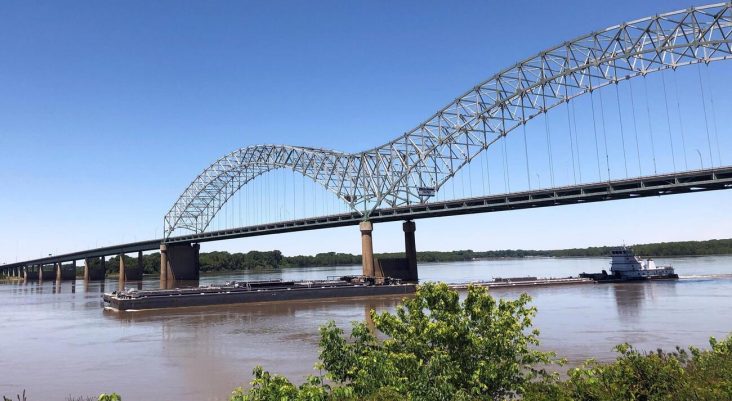Mississippi River projected to be at minus levels during harvest for third straight year
by August 15, 2024 11:50 am 571 views

Drought conditions have plagued farmers for the last two harvest seasons, but haven’t been a factor this growing season. One side impact has been on the water levels of the Mississippi River.
Last year, the river at Memphis dropped to an all-time low of minus 11.5 feet in October. It topped the previous record of minus 10.81 feet set in 2022. Despite consistent rain throughout much of the region, the river is projected to be at minus 3.2 feet by Aug. 27, according to NOAA’s National Water Prediction Service.
The mid-south hasn’t had drought-like conditions, but a lack of snow last winter in the upper Midwest and lower rain levels throughout the spring and summer have led to lower water levels with many tributaries in the river’s upper system.
Barge traffic stalled on the river during harvest last year, leading some farmers to dump their crops on the sides of the river or on islands created when the water level was low.
Higher freight rates and weaker basis loom for farmers as they begin to pull crops from their fields, Scott Stiles extension economics program associate for the University of Arkansas System Division of Agriculture said. Basis is the difference between the cash price and the futures price for a commodity.
“This is the third year in a row the river has gotten shallow at harvest time,” Stiles said, adding that “forecasts for river depth are subject to change and the gauge at Memphis is still well above the record lows seen last fall, however, the outlook points to steady decline through much of August.”
The Mississippi River is a vital artery for grain transportation. According to the U.S. Department of Agriculture’s Federal Grain Inspection Services, 57% of U.S. soybean exports and 47% of corn exports have been shipped out of New Orleans in the current marketing year.
The Mississippi River is also important for the movement of fertilizer. Industry sources estimate about 33% of urea and diammonium phosphate moves up the Mississippi River from the Gulf of Mexico.
“I’m not wanting to yell ‘fire’ in a crowded theater, but I do want to get this on people’s radar,” Stiles said. “Given the combination of a rapidly falling river, the onset of harvest and increasing barge freight, basis has already started to
Stiles said that since Aug. 1, corn basis has fallen 2-5-cents and soybeans 10-15-cents at some Mississippi River terminals.
“The weaker basis is normal at harvest time but will be exaggerated if the river becomes difficult to navigate,” he said. “The risk associated with a collapse in basis can be severe, as we saw in 2023. By the end of September last year, the soybean basis at West Memphis fell to $1.20 under futures. With corn and soybean prices currently at the lowest levels since 2020, a repeat of historic weakness in basis would be devastating to growers.”
Stiles said there are two ways farmers can offset some of the effects.
“Basis risk can be managed by utilizing basis contracts that lock in the basis and protect against further declines,” he said. “Most elevators offer these.”
Stiles said another option is for growers to store grain until after the peak harvest window.
“Having enough grain storage might mean getting some more bin space rented from a neighbor or getting a grain bagging machine,” he said.
The wait was worth it last year.
“For example, basis improved dramatically by mid-October last year,” Stiles said. “We may see a repeat of that this year with harvest starting a little earlier. A lot depends on the ability of barge traffic to navigate normally this fall. Adding further pressure, the U.S. could potentially see record corn and soybean production this year according to USDA’s projections.”
NOAA predicted the potential for low river levels in its spring outlook, noting historically low snow coverage in the upper Great Plains and western U.S.
The lower Mississippi River is fed by two big sources, the upper Mississippi River and the Ohio River, which converge at Cairo, Illinois. Kai Roth, senior hydrologist at NOAA’s Lower Mississippi River Forecast Center said the key to the river’s current levels is the Ohio River because the Ohio River can carry a larger volume of water than the Upper Mississippi River can.
“Right now, the Ohio is very low. It’s very dry and there’s not a whole lot of flow coming out of the Ohio,” he said. “The only saving grace we have right now is actually those floods we had on the upper Mississippi earlier in the year. It’s causing the lower Mississippi River to be a little bit higher than it could be.
“We’re not near the levels like we saw at this time in ‘22 and ’23 — yet,” Roth said, adding that that through October, weather in the Mississippi and Ohio basins tend to be dry.
“This time of year, we do not get the spring fronts coming through that produce a lot of rain on the basins,” he said. “I’m looking further out and I’m really not seeing much in the way of relief, at least in the near term.”
The river levels at Cairo are the bellwether for the lower basin, Roth said. The rises and falls at Cairo translate all the way down to the lower part of the river.
“Cairo is our main modeling point. So, when Cairo drops a little bit more than we expected everything downstream follows suit,” he said.
